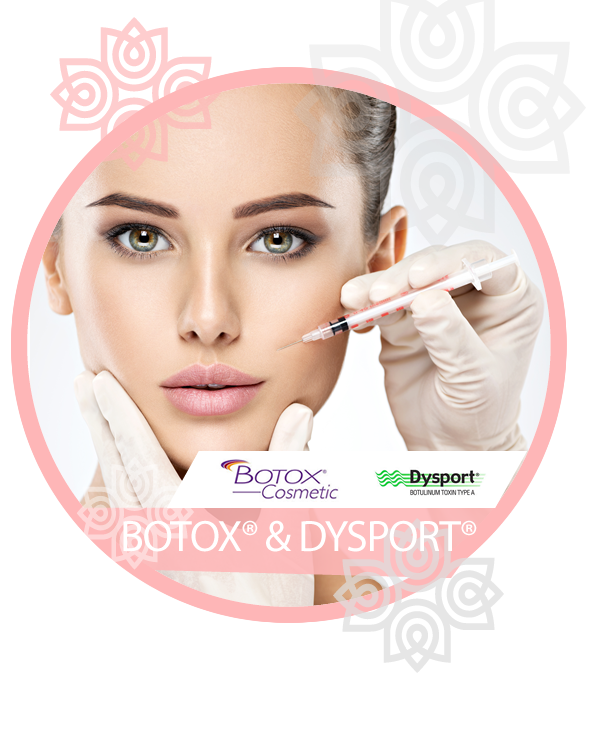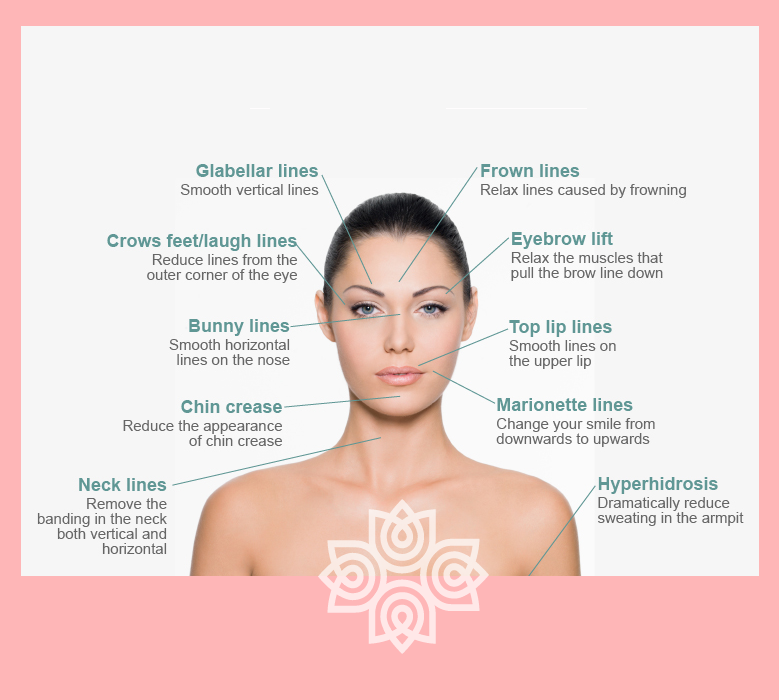
BOTOX® & DYSPORT®
- Botox® injections are the best known of a group of medications that use various forms of botulinum toxin to temporarily paralyze muscle activity. This toxin is produced by the microbe that causes botulism, a type of food poisoning.
- Botox® was the first drug to use botulinum toxin. Other products now include Dysport, Myobloc and Xeomin. Each is a little different, particularly when it comes to dosage units, so they aren’t interchangeable, it usually stay 3- 6 months.
- Dysport is a natural-looking, fast-acting, long-lasting prescription injection proven to help smooth moderate to severe frown lines between the eyebrows—without changing the look or movement of the rest of your face.
WHAT AREAS CAN BE TREATED WITH BOTOX®
Botox, a brand name for botulinum toxin type A, is commonly known for its cosmetic use in reducing wrinkles and fine lines on the face. However, Botox has a range of medical and cosmetic applications beyond wrinkle reduction. Here are some areas that can be treated with Botox:
1. Wrinkle Reduction: Botox is most famous for its cosmetic use in reducing the appearance of wrinkles and lines on the face. It is often used to treat crow’s feet (lines around the eyes), forehead wrinkles, and frown lines between the eyebrows (glabellar lines).
2. Forehead Lift: Botox can be used to lift the eyebrows and create a more youthful appearance by relaxing the muscles that pull the eyebrows downward.
3. Bunny Lines: These are the lines that form on the sides of the nose when you scrunch your nose. Botox can be used to smooth out these lines.
4. Lip Lines: Botox can be injected around the lips to reduce the appearance of vertical lip lines, often called «smoker’s lines.»
5. Chin Dimpling: Botox can be used to relax the muscles that cause dimpling or puckering of the chin.
6. Jawline Contouring: Botox can be used to relax the muscles in the jaw, creating a slimmer and more defined jawline.
7. Neck Bands: Vertical bands on the neck can be treated with Botox to create a smoother neck appearance.
8. Excessive Sweating (Hyperhidrosis): Botox injections can be used to block the signals that trigger sweat glands, reducing excessive sweating in areas like the underarms, hands, and feet.
9. Migraine Headaches: Botox injections have been approved for the treatment of chronic migraines by relaxing muscles and reducing pain signals.
10. Muscle Spasms and Twitching: Botox can be used to treat various muscle-related issues, such as eyelid twitching, facial spasms, and muscle stiffness.
11. Gummy Smile: Botox injections can be used to relax the muscles that cause a gummy smile, revealing less gum when smiling.
12. TMJ Disorder: Botox injections can help alleviate symptoms of temporomandibular joint (TMJ) disorder by relaxing the jaw muscles and reducing pain.
13. Crossed Eyes (Strabismus): Botox injections into specific eye muscles can help correct misalignment and improve eye coordination.
Permanent makeup uses tattoo techniques to enhance or reproduce features that are not pronounced or have been lost due to aging, a medical condition, or scarring. “Cosmetic tattooing” is most often used for the face, on the eyebrows, lashes and lips, but also can improve scars or uneven coloring of the skin (vitiligo) and restore the areola around a woman’s nipple after breast surgery. Unlike a regular tattoo, “microblading is a form of tattoo artistry where pigment is implanted under your skin with a manual handheld tool instead of a machine.













